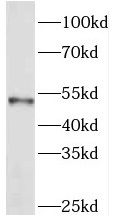Products
PICK1 antibody
Category:
Research Area:
- SPECIFICATIONS
- Product Name
- PICK1 antibody
- Catalogue No.
- FNab06434
- Size
- 100μg
- Form
- liquid
- Purification
- Immunogen affinity purified
- Purity
- ≥95% as determined by SDS-PAGE
- Clonality
- polyclonal
- Isotype
- IgG
- Storage
- PBS with 0.02% sodium azide and 50% glycerol pH 7.3, -20℃ for 12 months(Avoid repeated freeze / thaw cycles.)
Immunogen
- Immunogen
- protein interacting with PRKCA 1
- Alternative Names
- PRKCABP antibody
- UniProt ID
- Q9NRD5
- Observed MW
- 50-55 kDa
Application
- Tested Applications
- ELISA, IHC, WB, IP, IF
- Recommended dilution
- WB: 1:500-1:2000; IP: 1:200-1:1000; IHC: 1:20-1:200; IF: 1:20-1:200
Validated Images
 mouse brain tissue were subjected to SDS PAGE followed by western blot with FNab06434(PICK1 antibody) at dilution of 1:500
mouse brain tissue were subjected to SDS PAGE followed by western blot with FNab06434(PICK1 antibody) at dilution of 1:500
 IP Result of anti-PICK1 (IP:FNab06434, 4ug; Detection:FNab06434 1:500) with mouse brain tissue lysate 4400ug.
IP Result of anti-PICK1 (IP:FNab06434, 4ug; Detection:FNab06434 1:500) with mouse brain tissue lysate 4400ug.
 Immunohistochemistry of paraffin-embedded human prostate cancer using FNab06434(PICK1 antibody) at dilution of 1:50
Immunohistochemistry of paraffin-embedded human prostate cancer using FNab06434(PICK1 antibody) at dilution of 1:50
- Background
- Probable adapter protein that bind to and organize the subcellular localization of a variety of membrane proteins containing some PDZ recognition sequence. Involved in the clustering of various receptors, possibly by acting at the receptor internalization level. Plays a role in synaptic plasticity by regulating the trafficking and internalization of AMPA receptors. May be regulated upon PRKCA activation. May regulate ASIC1/ASIC3 channel. Regulates actin polymerization by inhibiting the actin-nucleating activity of the Arp2/3 complex; the function is competetive with nucleation promoting factors and is linked to neuronal morphology regulation and AMPA receptor(AMPAR) endocytosis. Via interaction with the Arp2/3 complex involved in regulation of synaptic plasicity of excitatory synapses and required for spine shrinkage during long-term depression(LTD). Involved in regulation of astrocyte morphology, antagonistic to Arp2/3 complex activator WASL/N-WASP function.



